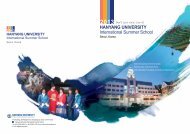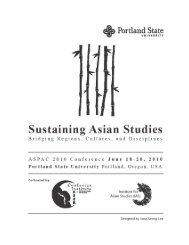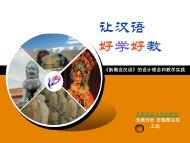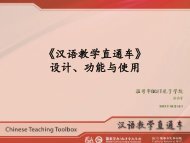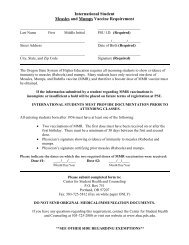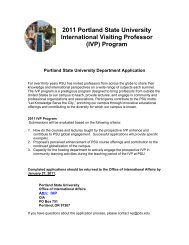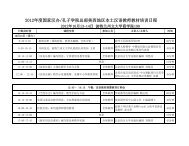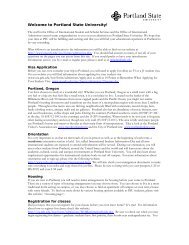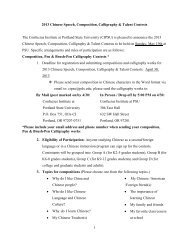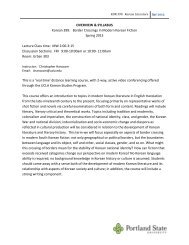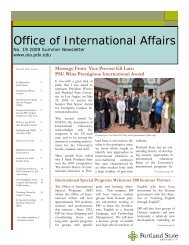ABSTRACTS - oia - Portland State University
ABSTRACTS - oia - Portland State University
ABSTRACTS - oia - Portland State University
Create successful ePaper yourself
Turn your PDF publications into a flip-book with our unique Google optimized e-Paper software.
ASPAC Conference 2010<br />
June 18 – 20, 2010 | <strong>Portland</strong>, OR<br />
East and West, Asia and Europe, development and backwardness, and social freedom and repression off a<br />
fruitful site in which to examine Korean conceptions of “Asia” and to discern where the boundaries of such<br />
constructions lie.<br />
~ ~ ~ ~ ~ ~ ~ ~ ~ ~<br />
Robert Fisher<br />
The 1860 Japanese Mission to the United <strong>State</strong>s<br />
The 1860 Japanese Mission to the U.S. was a momentous, and now largely forgotten, moment in American<br />
history. The samurai and attendants were the objects of immense public interest and at every stop on their<br />
brief tour were greeted by public throngs hoping to catch a glimpse of the strange “exotic” visitors. Part of<br />
the reason for this intense popular interest was because the Japanese were the first real foreign mission of its<br />
kind to visit the U.S. and was therefore symbolically very important to America’s changing popular image of<br />
itself as an emerging world power. On the other hand this mission, despite its obvious import to the national<br />
self-image, was extremely problematic due to the little issue of the Japanese not being “white.” Race has<br />
always been something of a bugbear in the American psyche, and perhaps at no greater time in American<br />
history that 1860, just five years before the outbreak of the Civil War. This presentation will look at how<br />
these competing and often contradictory views of the Japanese were depicted in the popular imagination at<br />
that time and the impact this visit had on U.S.- Japanese relations.<br />
~ ~ ~ ~ ~ ~ ~ ~ ~ ~<br />
Miho Fujiwara<br />
Japanese language learners' use of event anaphora in written discourse<br />
Unlike "hard rules" at morphological and syntactic levels, many discourse phenomena are usually governed<br />
by "principles" and "preferences," hence are hard to provide explicit instruction in a systematic way. It is,<br />
thus, undeniable that focus on sentence-level form tends to be prioritized in many foreign language teaching<br />
contexts, but discourse-level research and practice has also been attracting attention (cf. McCarthy, 1991;<br />
Thornbury, 2005).<br />
While grammatical competence focuses mainly on sentence-level grammar in terms of the rules that<br />
govern the formation of acceptable sentence, discourse competence is concerned with intersentential<br />
relationships. Such relationships are often described as cohesion and are realized by lexical or grammatical<br />
devices (Halliday and Hasan, 1976). Among a variety of beyond-sentence phenomena, our main concern is<br />
on referential cohesion. Especially this study will investigate how Japanese native speakers ONSs) and<br />
Japanese language learners (JLs) use event anaphora (demonstratives with sentential antecedent) to maintain<br />
overall coherence of a discourse.<br />
We built a comparable corpus between Japanese university students (JNS) and American university<br />
students (JL). In collecting data, an episode of Pingu, a Swiss clay animation, is presented to students as a<br />
prompt in producing a written narrative (Le., synopsis writing). The Japanese and American students were<br />
asked to reproduce the same Pingu story in their L1 and L2.<br />
The result shows that JNSs used event anaphora in object position rather than in subject positions while<br />
JLs hardly used event anaphora in object positions. In the presentation, we will also discuss implications<br />
of the results for Japanese language teaching.<br />
~ ~ ~ ~ ~ ~ ~ ~ ~ ~<br />
Michele Gamburd<br />
Demographics and Remittances: Labor Migration and Population Aging in Sri Lanka<br />
Sri Lanka stands at the conference of two major social trends: a demographic shift toward an aging<br />
population, and changing aspirations among migrant families. As time passes, the median age of Sri Lanka’s<br />
population increases. Cultural expectations dictate that daughters-in-law should care for elders in the home.<br />
Simultaneously, three decades of transnational labor migration of guest workers to the Gulf Cooperation<br />
Council (GCC) continues; in 2008, roughly 1.8 million Sri Lankans (over 23% of the country’s working-age<br />
11



